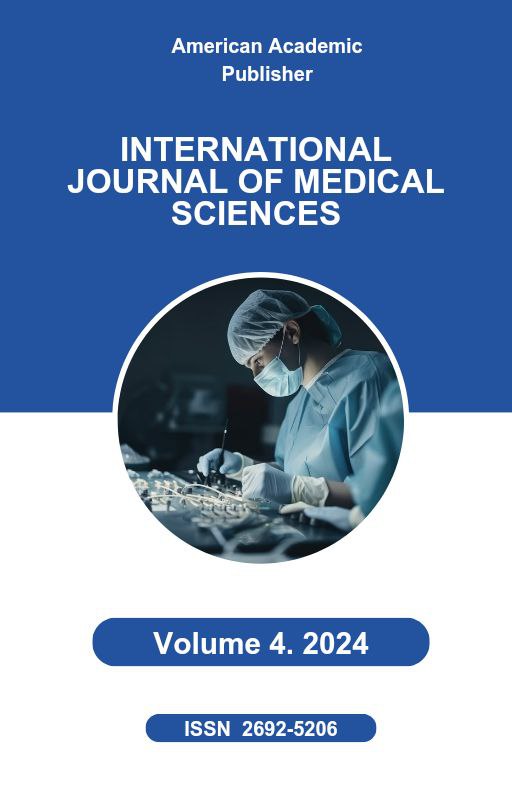 Articles
| Open Access |
https://doi.org/10.55640/
Articles
| Open Access |
https://doi.org/10.55640/
MECHANISMS OF ACTION OF VACUUM WOUND THERAPY
ISMAILOV U.S., MATMUROTOV K.J., YAKHUBOV I.Y., RAKHIMOV D. Dj. , Department of General Surgery, Tashkent State Medical University, Tashkent, Uzbekistan.Abstract
The article describes in detail action mechanisms of negative pressure wound treatment (NPWT) – one of the latest techniques used in various etiologies wound treatment. Negative pressure provides continuous evacuation of fluid, stimulates the proliferation of granulation tissue and effectively cleans the wound surface. Local prolonged negative pressure wound treatment is currently carefully developed, reliable, efficient and professional wound treatment technology. NPWT can significantly reduce time and cost of treatment.
Keywords
wound treatment, vacuum therapy, negative pressure wound treatment, vacuum assisted closure.
References
Blatun, L.A. Local Medication Treatment of Wounds / L.A. Blatun // Surgery. - 2011. - No. 4. -P. 51-59.
Datsenko, B.M. Theory and Practice of Local Treatment of Purulent Wounds / B.M. Datsenko, O.O. Shalimov,E.P. Bezuglaya. - Kyiv, 1995. - 383 p.
Svetukhin, A.M. Current State of the Problem of Using Antibacterial Therapyin Complex Surgical Treatment of Patients with Diabetic Foot Syndrome / A.M. Svetukhin, M.V. Prokudina // Russ. Med. Zhurn. - 1997. - Vol. 5, No. 24. - P. 1617-1620.
Chasnoit, A.Ch. Vacuum Therapy of Wounds Using the WaterLily Generator: A Tutorial / A.Ch. Chasnoit, V.N. Podgaysky, Ya.Ya. Koshelkov et al. – Minsk: BelMAPO, 2014. – 59 p.
Chebotar, I.V. Antibiotic Resistance of Biofilm Bacteria / I.V. Chebotar, A.N. Mayansky, E.D. Konchakova, et al. // Clinical Microbiology and Antimicrobial Chemotherapy. – 2012. – Vol. 14, No. 1. –P. 51–58.
Defranzo, A.J. The use of vacuum-assisted closure therapy for the treatment of lower-extremity wounds with exposed bone / A.J.Defranzo, L.C.Argenta, M. W. Marks et al. // Plast. Reconstruct. Surg. – 2001. –Vol.108, N5. – P.1184–1191.
Holzer, S.E. Costs and duration of care for lower extremity ulcers in patients with diabetes / S.E.Holzer,A. Camerota, L. Martens et al. // Clin. Ther. – 1998. – Vol.20, N1. – P.169–181.
Kairinos, N. The paradox of negative pressure wound therapy – in vitro studies / N.Kairinos, M.Solomons, D.A.Hudson // J. Plast. Reconstr. Aesthet. Surg. –2010. – Vol.63, N1. – P.174–179.
Labler, L. Vacuum-assisted closure therapy increases local interleukin-8 and vascular endothelial growth factor levels in traumatic wounds / L. Labler, M. Rancan, L. Mica et al. // J. Trauma. – 2009. – Vol.66, N3. – P.749–757.
Malmsjo, M. Comparison of bacteria and fungusbinding mesh, foam and gauze as fillers in negative pressure wound therapy – pressure transduction, wound edge contraction, microvascular blood flow and fluid retention / M.Malmsjo, R.Ingemansson, S. Lindstedt, L. Gustafsson // Int. Wound. [Epub ahead of print].
Morykwas, M.J. Vacuum-assisted closure: a new method for wound control and treatment: animal studies and basic foundation / M.J.Morykwas, L.C.Argenta, E.I.Shelton-Brown, W.McGuirt // Ann. Plast. Surg. – 1997. – Vol.38, N6. – P.553–562.
Morykwas, M.J. Vacuum-assisted closure: state of basic research and physiologic foundation /M. J. Morykwas, J. Simpson, K. Punger et al. // Plast. Reconstr. Surg. – 2006. – Vol.117, N7, suppl. –P.121S–126S.
Othman, D. Negative Pressure Wound Therapy Literature Review of Efficacy, Cost Effectiveness, and Impact on Patients’ Quality of Life in Chronic Wound Management and Its Implementation in the United Kingdom / D.Othman // Plast. Surg. Int. – 2012. – Vol.5. – R.374–398.
Brady R.A. Osteomyelitis and the role of biofilms in chronic infection / Brady R.A., Jason H.Calhoun, J.William Costerton et al. //Med. Microbiol. Immunol. – 2008. – Vol.52. – P.13–22.
Saxena, V. Vacuum-assisted closure: Microdeformations of wounds and cell proliferation / V. Saxena, C. W. Hwang, S. Huang et al. // Plast. Reconstr. Surg. – 2004. – Vol.114, N5. – P.1086–1096.
Schintler, M.V. Negative pressure therapy: theory and practice / M.V.Schintler // Diabet. Metab. Res. Rev. – 2012. – Vol.28, suppl.1. – P.72–77.
Steingrimsson, S. Negative-pressure wound therapy for deep sternal wound infections reduces the rate of surgical interventions for early re-infections / S.Steingrimsson, M.Gottfredsson, I.Gudmundsdottir et al. //Interact. Cardiovasc. Thorac. Surg. – 2012. – Vol.15, N3. – P.406–410.
Venturi, M. L. Mechanisms and clinical applications of the vacuum-assisted closure (VAC) Device: a review / M. L. Venturi, C. E. Attinger, A. N. Mesbahi et al. //Am. J. Clin. Dermatol. – 2005. – Vol.6, N3. – P.185–194.
Willy, C. Scientific background of the vacuum closure – an abstract / C.Willy, H.Gerngross // Zentralbl. Chir. – 2004. – Vol.129, suppl.1. – P.S6
Article Statistics
Downloads
Copyright License

This work is licensed under a Creative Commons Attribution 4.0 International License.

